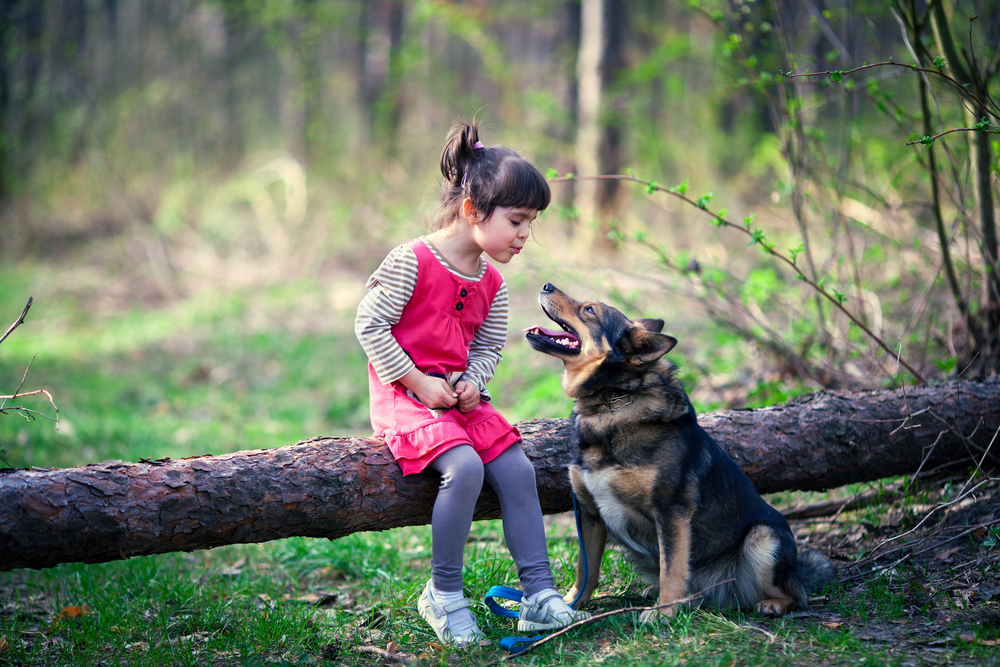A dog is an incredible animal: he can sniff out a dropped piece of food from across the house, stay alert for the (clearly deadly) presence of the mailman, and still find the time to love his owner unconditionally. The one thing he may struggle with, however, is communicating his wants and needs in a way that his pet parent can easily understand. While some new behavioral studies are exploring innovative solutions like using “talking” buttons to let dogs speak with their paws, the most reliable method of interspecies contact remains reading dog body language.
Certain canine gestures are pretty clear no matter what species is seeing them – a growl with exposed teeth, for example, accompanied by snapping of the jaws, means stay away from me! Others are more ambiguous, old wives’ tales aside. From nose to tail, a dog is “speaking” more often than most humans realize, and it turns out that he’s got a lot to say. Read on for a helpful guide to reading your dog’s body language, including useful facts about physical cues, canine behavior, and other insightful information for pet parents.
Playacting Behaviors
When a pack of dogs wants to bond, or unwind after a long day of travelling and hunting, they don’t have the option of flipping on Netflix. Instead, dog packs engage in frequent play fighting, stalking, and so on to reinforce pack bonds and establish a rough “pecking order” among the members. Play-fighting with a more dominant pack member, for example, might mean a submissive pack member showing their belly in vulnerability or licking the underside of the dominant member’s chin; the latter a submissive behavior used by wolf pups to beg for food from a mother wolf. This play-fighting, however, can resemble aggressive stances to the uninformed.
When a domestic dog is play-fighting, or attempting to engage in play, he will:
- Keep his ears un-flattened, and his mouth slightly open
- Bend his torso down to the ground with his backside high in the air, forming an incline
- Keep his tail up and potentially wagging as well – never tucked or “draped” down
- Emit short “yip” style barks, designed to encourage playmates, never growling
- Pat the ground with his front two paws, one after the other in a “thump-thump” motion
Pet parents can encourage this behavior and engage in play by mirroring him before playing with toys or gently wrestling. They’d do this by getting low on the floor and mimicking the same “thump thump” motion with their hands on the ground. This posture and action is called the play bow, and it’s a very important part of canine culture. It’s a dog’s way of saying hey, I’d really like to play, as well as an agreement to play when another dog play-bows to him. Engaging with other dogs in a setting like a dog park, he’ll offer or accept play bows from other dogs in order to play fairly, with no injuries or hurt feelings. Without the play bow, a dog may not realize his potential playmate isn’t trying to actually hurt him.

The Nose Knows – And So Does The Muzzle
The first part of his body to enter an unknown environment, his nose and muzzle are excellent indicators of his mood. Many people, particularly those afraid of dogs, associate any showing of their teeth as a sign of aggression in dogs, but this simply isn’t true. Consider how often humans “show their teeth” – e.g., chewing, smiling, grinning, yawning, or even while breathing heavily post-exertion. None of these activities are necessarily associated with aggression, but ripping off a piece of bread with one’s teeth while maintaining direct, intense eye contact with someone else certainly could be taken that way.
Just as in human body language, it’s the total package of movements, positions, and intention that matters with dogs. If he is showing his teeth, consider if these other indicators are also present:
Is his body position wedge-shaped or his shoulders hunched?
- Is the fur on the back of his neck (i.e., his hackles) raised or bristling?
- Is he making low, growling vocalizations continually?
- Is his nose/muzzle wrinkled, specifically to expose his front teeth?
- Is he lunging and snapping his teeth together towards a threat?
All of these indicators will typically accompany a threat response: a series of behaviors and positioning designed to tell a potential predator they should expect a fight if they attack. If, on the other hand, his ears are perked or at rest, his hackles are down, and his total body language is relaxed, he may actually be smiling. This canine smile, called a submissive grin, is one of the ways a dog demonstrates to other members of his pack that he is not posing a threat to them. He’s looking for attention, but specifically wants to make sure that the object of his attention, whether canine or human, doesn’t think he’s trying to fight.
Speaking Through The Ears
His ears feature tendons and muscles for a reason: they’re meant to move and keep him updated on his immediate environment. While he hears sounds on the lower register of the audible spectrum with roughly the same accuracy as humans – about 20 Hz – it’s in the upper register that he truly shines. While his pet parent can only hear high-pitched sounds up to about 20,000 Hz, a dog’s hearing extends more than three times over that, in the 70,000 Hz to 100,000 Hz range. This super-hearing ability is why dog whistles work so well at grabbing his attention: they send him a very easy-to-hear whistle between 23,000 Hz to 54,000 Hz, while all the human “whistler” hears is a soft hissing noise.
That incredible hearing means that if he sits up straight, cocks his head, or starts barking at what seems to be nothing, chances are he’s simply hearing something loud and clear that his human companion isn’t able to. His ears will stand up as straight as they are able to in this situation, and even floppy-eared breeds like beagles will perk up the base of their ears, even if gravity means that they can’t get their full ear length airborne.

When he is tense or threatened, ears are one of the first physical indicators of his mood and state of mind. Because they are large, comparatively thin, and filled with blood vessels, in a fight they can quickly become a painful liability if an opponent gets his teeth in. When a dog “pins” his ears back by flattening them against his skull, he’s attempting to get them out of the way of his opponent, and anticipating a physical altercation. If he’s crouched, teeth bared, growling, and his ears are pinned back, approaching him or physically entering the space between him and his opponent can be a dangerous endeavor. Instead, attempts should be made to encourage the opponent to leave, or an already-attached lead should be used to guide him to a safe, empty area nearby.
The Eyes And Focus
Pupils, the black dots found in the center of each eye, work like a camera aperture: the wider they are, the more they’re taking in, and vice-versa. When a dog is stressed, anxious, or fearful, his pupils will be larger and wider than usual, and the position of his eye may reveal more of the whites than normal – a behavior sometimes called “whale eye.” Conversely, if he is relaxed and happy, he may appear to squint or partially close his eyes, creating an almond shape. This means he isn’t experiencing stress, and has no reason to need his eyes open and taking everything in – he trusts his pet parent and immediate environment.
The Tail’s Tale
A common misconception in reading dog body language is that a wagging tail means that a dog is happy and completely safe to approach. A lot of this myth comes from the fact that the impression of a barking, lunging, or angry dog generally triggers notice in his fangs, his proximity, and his barking – not his tail. Watch a video of a barking, lunging dog and there’s a better-than-average chance his tail will actually be sticking straight up or wagging, just as it would if he was being harmlessly playful. This is because the state a wagging tail is communicating isn’t necessarily happiness and safety, it’s emotional excitement.
Human blood pressure rises when a physical fight is imminent and in anticipation of seeing a loved one – same result, but two very different triggers. This same concept applies to the wagging tail of a dog, as well as his teeth-showing behaviors: it’s the total package that tells the truth.

A dog’s body language is a physical vocabulary built through thousands of years of evolution, reinforced every time they come into contact with a predator, threat, packmate, or playmate. Learning this important lexicon isn’t just enjoyable, it’s also crucial to deepening and strengthening the bond between a dog and his owner.
Sources Cited:
- Gibeault, Stephanie, MSc, CPDT. “How To Read Dog Body Language.” American Kennel Club (AKC.org), January 27, 2020, https://www.akc.org/expert-advice/advice/how-to-read-dog-body-language/. Accessed September 5, 2020.
- “Curious Kids: How far away can dogs smell and hear? The Conversation.com, June 8, 2020, https://theconversation.com/curious-kids-how-far-away-can-dogs-smell-and-hear-139959. Accessed September 5, 2020.
- Capoot, Ashley. “How do you teach a dog how to talk? This woman is figuring it out as millions tune in.” Today.com, July 2, 2020, https://www.today.com/pets/how-teach-dog-talk-buttons-according-one-owner-t185757. Accessed September 5, 2020.
- “7 Tips on Canine Body Language.” ASPCApro.org, (no published date), https://www.aspcapro.org/resource/7-tips-canine-body-language. Accessed September 5, 2020.




